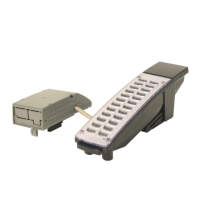Direct Inward Dialing (DID) or Direct Dial In (DDI)
162 Features Aspila EX Software Manual
Programming
•10-09-01 : DTMF and Dial Tone Circuit Setup
If the system has DTMF DID trunks, be sure to reserve at least one circuit for analogue trunk
DTMF reception (type 0 or 2). There must be an available receiver for each DTMF DID
trunk.
• Use the following as a guide when allocating DTMF receivers:
- In light traffic sites, allocate one DTMF receiver for every 10 devices that use them.
- In heavy traffic sites, allocate one DTMF receiver for every five devices that use them.
•14-05-01 : Trunk Groups
Put DID trunks in the same trunk group (other than group 1). If you have several types of
DID trunks, put each type in a separate trunk group.
•15-07-01 : Programming Function Keys
You can assign line keys for DID trunks (1-200). Without line keys, DID calls ring line
appearance (CALL) keys.
•20-09-01 : Class of Service Options (Incoming Call Service) - Second Call for DID/ DISA/
DIL/ E&M
Enable (1) or disable (0) an extension’s ability to receive a second call from a DID, DISA,
DIL, or tie line caller.
•21-01-02 : System Options for Outgoing Calls - Intercom Interdigit Time
Set the time-out interval for DID callers that don’t dial. After this interval, the DID call routes
according to Vacant Number Intercept programming.
•22-01-06 : System Options for Incoming Calls - DID Ring-No-Answer Time
Set the DID Ring-No-Answer (RNA) Intercept interval (0-64800 seconds). In systems with
RNA Intercept, the DID call rings the destination extension for this interval and then rings
Intercept Ring Group.
•22-02-01 : Incoming Call Trunk Setup
For each Night Service Mode, enter service type 3 when the trunk should be a DID trunk.
•22-04-01 : Incoming Extension Ring Group Assignment
Assign extensions to Ring Groups. Calls ring the extensions according to programming in 22-
06.
•22-09-01 : DID Basic Data Setup - Expected Number of Digits
For each DID Translation Table (1-20), enter the number of digits the table expects to receive
from the CO (8 maximum). For example, for a table used with 3-digit DID service, enter 3.
•22-09-02 : DID Basic Data Setup - Received Vacant Number Operation
Selectively enable (1) or disable (0) Vacant Number Intercept based on each DID Translation
Database (Program 22-11-01 and 22-11-02).
•22-10-01 : DID Translation Table Setup
Assign the start and end range of DID Translation Table entries (1-2000) to each DID Trans-
lation Table (1-20).
•22-11-01 : DID Translation Table Number Conversion - Received Number
For each DID Translation Table entry (1-2000), specify the digits received by the system
(eight max.).
•22-11-02 : DID Translation Table Number Conversion - Target Number
For each DID Translation Table entry (1-2000), specify the extension the system dials after
translation (24 digits max.)
•22-11-03 : DID Translation Table Number Conversion - Dial-In Name
For each DID Translation Table entry (1-2000), specify the name that should show on the
dialed extension’s display when it rings (twelve characters max.)

